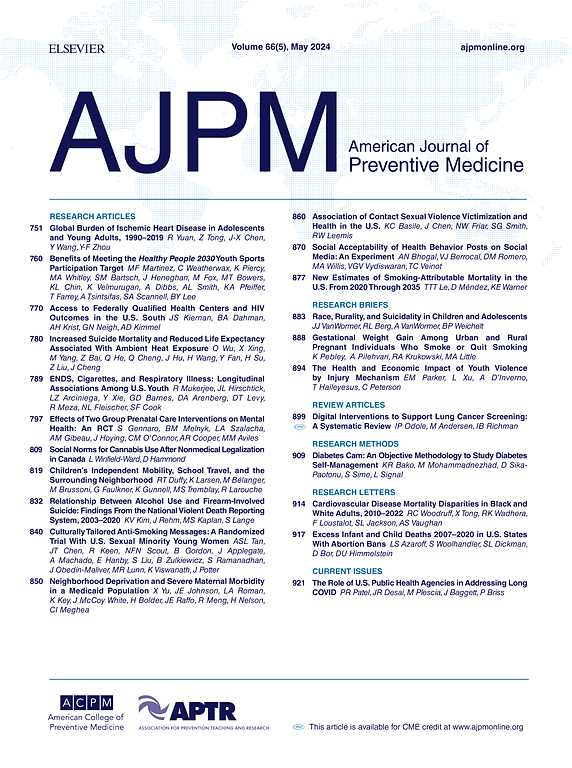Effects of Physical Activity on the Gut Microbiota in Late Pregnancy
IF 4.5
2区 医学
Q1 MEDICINE, GENERAL & INTERNAL
引用次数: 0
Abstract
Introduction
This investigation examined how moderate physical activity in late pregnancy affects gut microbiota using next-generation sequencing techniques, providing evidence of maternal benefits health.
Method
A prospective cohort study was conducted involving 23 pregnant women at 32 weeks of gestation. Fecal samples were subjected to 16S rDNA sequencing, and daily physical activity levels were recorded. Participants were stratified into two groups: T1 (≥30 minutes/day, consisting of 18 women) and T2 (<30 minutes/day, consisting of 5 women). Bioinformatics methods were employed to analyze gut microbiota composition, diversity, and its correlation with physical activity levels.
Results
The dominant phyla identified in both groups included Firmicutes, Bacteroidetes, Actinomycetes, and Proteobacteria. Alpha diversity and principal coordinate analysis indicated no significant differences in microbial diversity. However, LEfSe analysis identified an enrichment of Christensenellaceae and Prevotella stercorea in group T2. The T1 group demonstrated a more complex and stable gut microbial network, illustrated by positive correlations among the microbes. Spearman analysis revealed significant associations between activity levels and specific gut microbes: sedentary behavior was correlated with Romboutsia (P = 0.033, R = -0.445) and Senegalimassilia (P = 0.043, R = -0.443); light-intensity activity with Phascolarctobacterium (P = 0.015, R = -0.500); and moderate-intensity activity with Parasutterella (P = 0.040, R = 0.432).
Discussion
Moderate physical activity during late pregnancy enhances the stability and complexity of gut microbiota, providing benefits for maternal health. Next-generation sequencing offers valuable insights into the relationship between exercise and gut microbiota in pregnant women.
体育锻炼对妊娠后期肠道微生物群的影响
本研究利用新一代测序技术研究了妊娠后期适度体育锻炼如何影响肠道微生物群,为孕产妇健康益处提供了证据。方法对23例妊娠32周的孕妇进行前瞻性队列研究。对粪便样本进行16S rDNA测序,并记录每日体力活动水平。参与者分为两组:T1组(≥30分钟/天,包括18名女性)和T2组(<;30分钟/天,包括5名女性)。采用生物信息学方法分析肠道菌群组成、多样性及其与身体活动水平的相关性。结果两组的优势门均为厚壁菌门、拟杆菌门、放线菌门和变形菌门。α多样性和主坐标分析显示微生物多样性差异不显著。然而,LEfSe分析发现T2组富集了Christensenellaceae和Prevotella stercorea。T1组表现出更复杂和稳定的肠道微生物网络,微生物之间的正相关说明了这一点。Spearman分析显示,活动水平与特定肠道微生物之间存在显著关联:久坐行为与Romboutsia (P = 0.033,R = -0.445)和Senegalimassilia (P = 0.043,R = -0.443)相关;对Phascolarctobacterium光强活性(P = 0.015,R = -0.500);中强度与副菌的活性(P = 0.040,R = 0.432)。妊娠后期适度的身体活动可增强肠道菌群的稳定性和复杂性,有利于孕产妇健康。下一代测序为孕妇运动和肠道微生物群之间的关系提供了有价值的见解。
本文章由计算机程序翻译,如有差异,请以英文原文为准。
求助全文
约1分钟内获得全文
求助全文
来源期刊

American Journal of Preventive Medicine
医学-公共卫生、环境卫生与职业卫生
CiteScore
8.60
自引率
1.80%
发文量
395
审稿时长
32 days
期刊介绍:
The American Journal of Preventive Medicine is the official journal of the American College of Preventive Medicine and the Association for Prevention Teaching and Research. It publishes articles in the areas of prevention research, teaching, practice and policy. Original research is published on interventions aimed at the prevention of chronic and acute disease and the promotion of individual and community health.
Of particular emphasis are papers that address the primary and secondary prevention of important clinical, behavioral and public health issues such as injury and violence, infectious disease, women''s health, smoking, sedentary behaviors and physical activity, nutrition, diabetes, obesity, and substance use disorders. Papers also address educational initiatives aimed at improving the ability of health professionals to provide effective clinical prevention and public health services. Papers on health services research pertinent to prevention and public health are also published. The journal also publishes official policy statements from the two co-sponsoring organizations, review articles, media reviews, and editorials. Finally, the journal periodically publishes supplements and special theme issues devoted to areas of current interest to the prevention community.
 求助内容:
求助内容: 应助结果提醒方式:
应助结果提醒方式:


